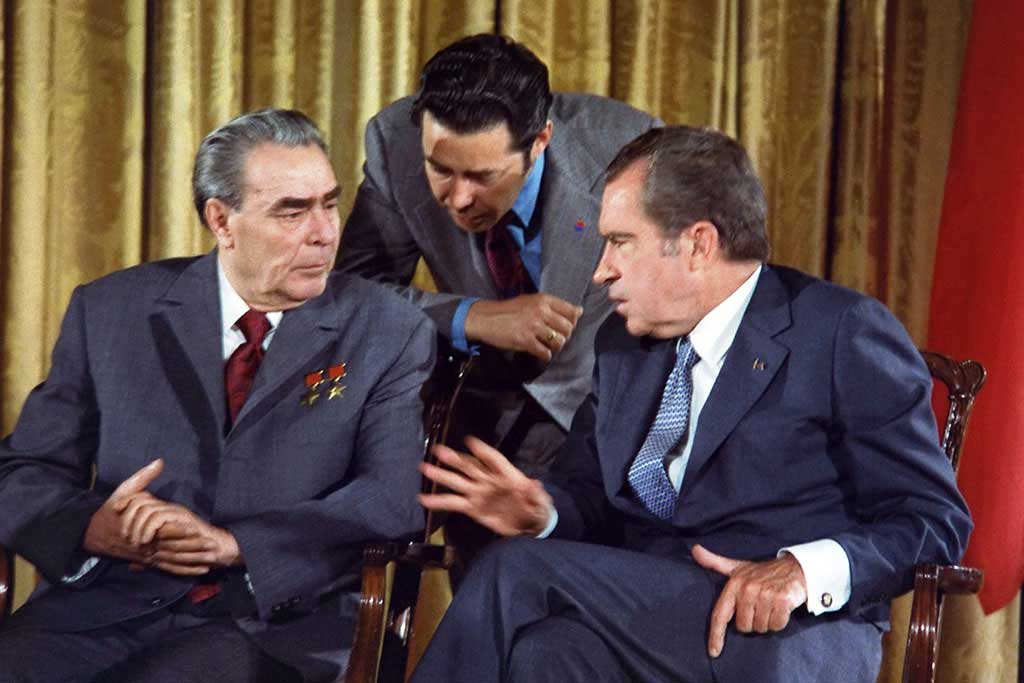1964-1985
After Khrushchev’s eventful reign the more reactionary Era of Stagnation followed. It was the time of Leonid Brezhnev, relaxed international relations and internal standstill.

Richard Nixon Meets Leonid Brezhnev During the Soviet Leader’s Visit To The U.S., 19 June 1973. Photo by Robert L. Knudsen
Stagnation
Many believed that Khrushchev’s Thaw had gone too far and had to change. Brezhnev’s time was the time of stagnation and limited freedom. Again censorship increased and political dissidents were oppressed and imprisoned. Communist propaganda saw its revival.
Foreign policy
In 1968, Czechoslovakia was going through the so-called “Prague Spring”. Alexander Dubcek was experimenting with liberal reforms, which were to be called “socialism with a human face”.
Moscow thought that they had gone too far and sent tanks in. This came to be known as “the Brezhnev doctrine”. It justified military intervention in Soviet satellite states.
Détente
The time from 1969-72 is known as the time of Relaxation of Tensions (Détente). The Soviet Union and USA made several efforts to mutually contain the arms race and minimalize conflict. Its peak was Richard Nixon’s visit to Moscow in 1972.
Another triumph was the Helsinki Accords (1975), when the Western countries agreed to accept Soviet dominion in Eastern Europe in the event it guaranteed more freedoms for people in this region.
After 1972, relations turned colder again and remained so until the Perestroika of 1985.
Brezhnev’s Stagnation
1964-1985
After Khrushchev’s eventful reign the more reactionary Era of Stagnation followed. It was the time of Leonid Brezhnev, relaxed international relations and internal standstill.
Richard Nixon Meets Leonid Brezhnev During the Soviet Leader’s Visit To The U.S., 19 June 1973. Photo by Robert L. Knudsen
Stagnation
Many believed that Khrushchev’s Thaw had gone too far and had to change. Brezhnev’s time was the time of stagnation and limited freedom. Again censorship increased and political dissidents were oppressed and imprisoned. Communist propaganda saw its revival.
Foreign policy
In 1968, Czechoslovakia was going through the so-called “Prague Spring”. Alexander Dubcek was experimenting with liberal reforms, which were to be called “socialism with a human face”.
Moscow thought that they had gone too far and sent tanks in. This came to be known as “the Brezhnev doctrine”. It justified military intervention in Soviet satellite states.
Détente
The time from 1969-72 is known as the time of Relaxation of Tensions (Détente). The Soviet Union and USA made several efforts to mutually contain the arms race and minimalize conflict. Its peak was Richard Nixon’s visit to Moscow in 1972.
Another triumph was the Helsinki Accords (1975), when the Western countries agreed to accept Soviet dominion in Eastern Europe in the event it guaranteed more freedoms for people in this region.
After 1972, relations turned colder again and remained so until the Perestroika of 1985.
Leonid Brezhnev